Effective Methods to Clean Your Concrete Patio
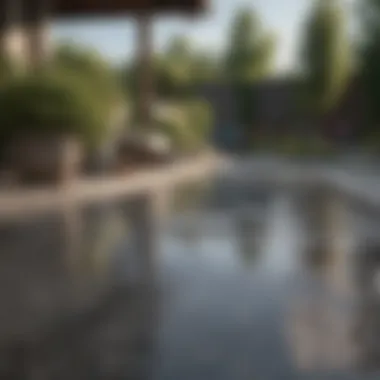
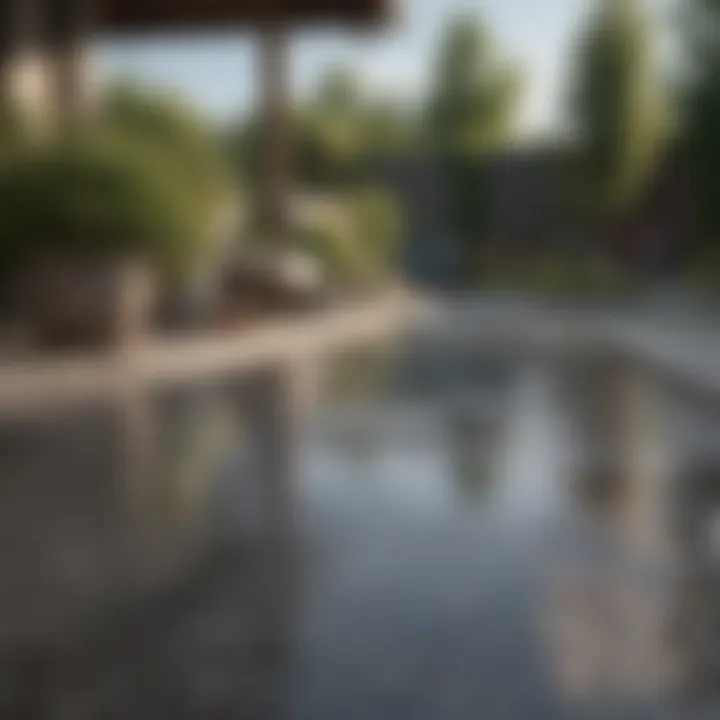
Intro
Cleaning a concrete patio can be a daunting task, especially without the assistance of a pressure washer. Many homeowners might struggle with this chore, wondering how to effectively remove dirt, grime, and stains. However, with the right methods, tools, and solutions, it is possible to restore your patio's appearance without the need for high-pressure water. This guide will explore various effective techniques, ensuring that even those with minimal experience can achieve a clean and inviting outdoor space.
Design Inspiration
When envisioning an outdoor space, consider how a clean patio enhances the overall environment. The patio serves as an extension of your home and can be a focal point for relaxation and gatherings. Achieving a spotless surface sets the stage for design inspirations, whether that be for a cozy seating area or a vibrant garden.
Trending Styles
Many contemporary outdoor designs feature a concrete patio as a base for various aesthetics. Here are some popular styles:
- Minimalist: Clean lines, uncluttered spaces, and simplicity are key elements.
- Industrial: Use raw materials alongside furniture made of metal or wood. This look often pairs well with exposed concrete surfaces.
- Rustic: Incorporate wooden accents or plants to soften the hardness of concrete.
These styles can help homeowners define how they want their patio to appear, driving the cleaning process to align with their vision.
Color Palettes
Color can significantly impact the atmosphere of your outdoor area. Light colors can make spaces feel larger, while darker tones provide intimacy. Some combinations include:
- Soft whites and greys for a serene feel.
- Earthy tones such as browns and greens for a natural vibe.
- Bold accents like navy or ochre to make a statement.
Choosing a color palette will stimulate interest and highlight your newly cleaned patio.
Practical Tips
Once you decide on a design inspiration, it is essential to maintain the cleanliness and integrity of your concrete patio. These practical tips can assist homeowners in keeping their space appealing.
Maintenance & Care
Regular maintenance prevents tougher stains from forming. Here are some practices:
- Sweep regularly: Keep your patio free from debris to avoid staining.
- Use mats: Place mats in high-traffic areas to minimize wear and tear.
- Re-seal periodically: Occasionally, reapply a sealer to protect the surface from moisture and stains.
Budgeting & Planning
Cleaning your concrete patio does not have to be expensive. Here are some cost-effective methods:
- Homemade cleaning solutions: Simple ingredients like vinegar and baking soda can yield great results without hefty costs.
- Basic tools: A broom, scrub brush, and bucket are often sufficient.
- Time management: Plan a cleaning day where you can focus entirely on patio care without rush.
Consistent maintenance combined with effective cleaning techniques enhances the longevity of your patio’s appearance and functionality.
Prologue to Concrete Patio Cleaning
Cleaning a concrete patio is an essential task that homeowners often overlook. Regular maintenance not only enhances the aesthetic appeal of the space but also prolongs the lifespan of the patio itself. Concrete can easily attract dirt, grime, and stains, which can create an uninviting atmosphere. Thus, knowing effective cleaning methods can make a notable difference in the outdoor living experience.
Understanding the Importance of Regular Cleaning
Regular cleaning is crucial for several reasons. First, it prevents the buildup of harmful substances. For example, oil stains or mold can be detrimental not only to the surface but also to the surrounding environment. Second, a clean patio provides a welcoming area for gatherings and leisure activities. Neglecting maintenance can lead to more significant issues down the line, necessitating costly repairs. Lastly, regular cleaning maintains the structural integrity of the concrete, making it less likely to crack or crumble over time.
Benefits of Cleaning without a Pressure Washer
Many homeowners opt for pressure washers to clean concrete surfaces. However, there are several compelling reasons to consider alternative methods.
- Gentleness on Surfaces: Cleaning without a pressure washer is less likely to damage concrete. High-pressure streams can erode the surface, creating uneven textures and making the patio more susceptible to future stains and damage.
- Eco-Friendly Options: Without the need for harsh detergents, homeowners can use natural cleaning solutions that are safer for pets and plants nearby. Ingredients like vinegar or baking soda are practical choices that yield effective results.
- Cost-Effectiveness: Not everyone owns a pressure washer, and renting one can be expensive. Traditional cleaning with simple tools minimizes costs while yielding satisfactory results.
"A clean patio is not just a visually appealing space; it is also a functional living area that can be enjoyed year-round."
Using these methods can lead to a more manageable routine, not only for today but for future maintenance as well. By understanding the importance of regular cleaning and the benefits of alternative techniques, homeowners can create a welcoming and inviting outdoor space that enhances their home.
Assessing Your Concrete Patio
Assessing your concrete patio helps guide the cleaning process. This step is essential for understanding what you are working with and what you need to do. By knowing the current state of the surface, you can choose the most effective cleaning methods without accidentally damaging it. Also, identifying stains and understanding their nature enables you to pick the right cleaning solution.
Identifying Different Types of Stains
When cleaning a concrete patio, one of the first steps is identifying the stains present. Different stains require specific approaches for removal.
Oil Stains
Oil stains can be a common problem for patios, especially if you often barbecue or park your vehicles nearby. These stains usually appear dark and can absorb dirt, making them more difficult to remove over time. They can deeply penetrate the concrete surface if not treated promptly. For most homeowners, addressing oil stains is a crucial aspect because they can create unsightly marks and hinder the overall appearance of the patio. The dark nature of the stain sometimes makes it less visible when wet, but it stands out significantly when dry, creating an uneven look on the concrete surface.
Moss and Algae Growth
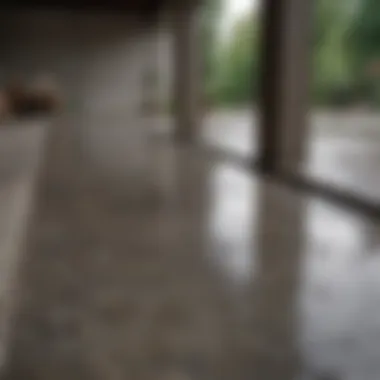
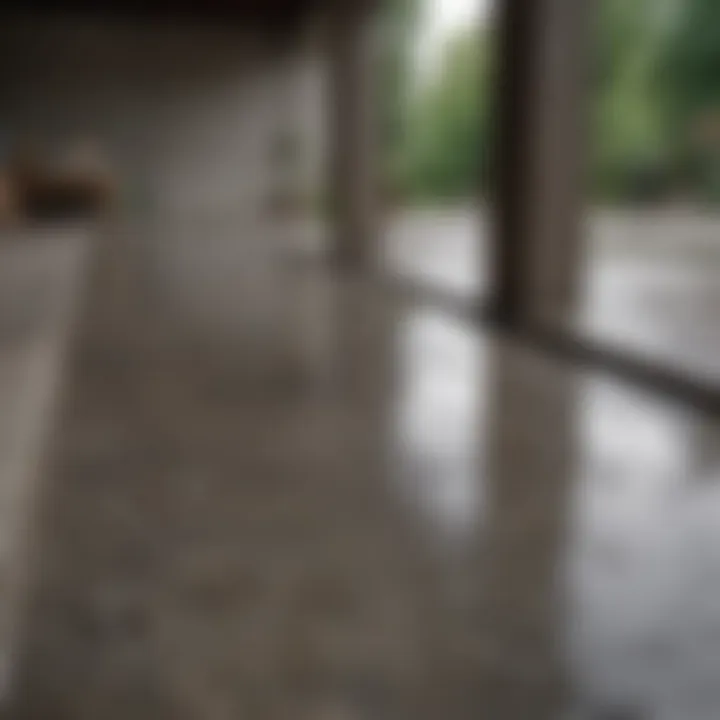
Moss and algae can thrive in damp or shaded areas of the patio. They create a green or blackish hue, which not only affects the aesthetics but can also make surfaces slippery and hazardous. Identifying such growth is vital, as it indicates moisture retention and potential structural issues in the patio. Cleaning moss and algae regularly helps maintain safety and prevents damage to the concrete, as the roots can expand and further erode the material over time.
Grime and Dirt Accumulation
Grime and dirt can build up from various everyday activities such as foot traffic, weather exposure, and spills. These accumulated layers can dull the finish of the concrete, making it unsightly. Identifying accumulation early is crucial because, over time, it can combine with other debris and stains, complicating the cleaning process later. Regularly assessing this buildup is beneficial, as it allows homeowners to implement a cleaning schedule that maintains the patio's appearance and longevity.
Evaluating Surface Condition
Evaluating the overall condition of the concrete patio is just as important as identifying stains. Surface condition informs the cleaning process and whether any repairs might be necessary before or after cleaning.
Cracks and Chips
Concrete can develop cracks and chips due to weather conditions, heavy use, or poor installation. These imperfections can worsen if ignored, leading to further deterioration. Identifying such issues is essential for planning a cleaning approach that minimizes damage. Homeowners should consider this aspect when evaluating because deep cleaning methods may exacerbate existing cracks. Filling cracks before cleaning can help protect the concrete surface during the process and maintain its integrity.
Sealing and Coatings
Assessing existing sealants and coatings on a concrete patio is also vital. Sealed surfaces can sometimes make cleaning easier, but they might also require specific cleaning products that won’t harm the seal. Homeowners should check how well the current sealant is holding up. If it appears worn, a re-seal may be needed after the cleaning process. Evaluating these points ensures choose the right methods and products that will enhance the patio's life and visual appeal without causing unintentional damage.
Understanding the condition of your concrete patio is key to effective cleaning and maintenance.
Preparation for Cleaning
Effective cleaning of a concrete patio is not just about applying a solution and scrubbing away. It requires thoughtful preparation to ensure that the process is efficient and the results satisfying. This preparation phase sets the stage for a successful cleaning endeavor. It allows you to gather necessary tools, assess the condition of your patio, and create a workspace that promotes safety and effectiveness.
A well-prepared cleaning setup minimizes potential damage to both the patio surface and surrounding elements. Furthermore, taking the time to prepare allows you to identify the best cleaning methods tailored to the specific types of stains or dirt present on your patio. Let's explore the necessary tools and steps that will aid in this preparation.
Gathering Necessary Tools and Supplies
Broom and Dustpan
A broom and dustpan are essential for any cleaning task. In the context of concrete patio cleaning, they play a crucial role. Before using any cleaning solutions, it is crucial to remove loose dirt, debris, and leaves from the surface. This prevents additional scratching or damage that might occur if such materials are ground into the concrete during scrubbing.
The characteristic of a heavy-duty broom makes it particularly effective on concrete surfaces. While typical indoor brooms may not suffice, outdoor brooms designed for rough surfaces can effectively gather larger debris without damaging the patio. Their unique feature lies in their sturdiness, allowing them to handle coarse textures. Thus, utilizing a broom is a beneficial first step in the cleaning process.
Mop and Bucket
Once the loose debris has been removed, a mop and bucket come into play. This duo is particularly helpful in dealing with stains that require a liquid solution for effective cleaning. The mop allows for a more concentrated cleaning of specific areas, ensuring that stains do not linger post-cleaning.
The primary characteristic of a mop designed for outdoor surfaces is its absorbency and durability. Unlike regular mops, those meant for outdoor use can withstand rougher handling and harsher cleaning solutions. A significant advantage of using a mop and bucket is the ability to apply cleaning solutions evenly across the surface without excessively wetting the area, which can lead to further staining.
Scrubbing Brushes
Scrubbing brushes provide the necessary muscle for tackling tougher stains on concrete. They are particularly effective for scrubbing away dirt, moss, and other stubborn residues that refuse to budge. A stiff-bristled brush can penetrate into the texture of the concrete, reaching deep-set grime.
What makes scrubbing brushes an essential tool is their design. Many brushes are equipped with a long handle, which allows for comfortable use without excessive bending or kneeling. This unique feature reduces strain on the back and knees during cleaning. However, it is essential to choose brushes that are tough yet will not damage the concrete surface.
Cleaning Solutions
The right cleaning solutions are pivotal in achieving a clean patio surface. Different stains may require different types of solutions. Applying an effective solution against a specific type of stain will ensure a cleaner and more satisfying result.
Cleaning solutions designed specifically for concrete are often formulated to break down oil, dirt, and stains without being overly harsh on the surface. A notable benefit is the variety of eco-friendly options available, which allow homeowners to clean their spaces without harming the environment. These solutions allow for specialized techniques that can target specific stains effectively, thus making them advantageous for thorough cleaning.
Creating a Safe and Effective Workspace
Removing Furniture and Fixtures
Before starting the actual cleaning process, it is important to remove any furniture or fixtures from the patio. This step ensures that these items do not obstruct the cleaning process and prevents them from becoming damaged by cleaning solutions or debris. Additionally, items like patio chairs or tables can easily stain if accidentally left on wet concrete.
The key characteristic of clearing the workspace is the enhanced access to the patio surface. With no items in the way, it's easier to identify stains and focus on trouble spots. One unique feature of this action is the peace of mind it provides: homeowners can clean without worrying about accidentally damaging or staining their outdoor furniture.
Protecting Surrounding Areas
Protecting surrounding areas is another essential step. As cleaning solutions can sometimes splatter or seep, covering nearby plants, fences, or non-concrete surfaces is wise. Using tarps or plastic sheeting can prevent unintended damage and maintain cleanliness beyond the patio area.
The characteristic of safeguarding these areas is to ensure that nothing else is impacted by the cleaning process. Proper protection means you can fully focus on the task without worrying about potential problems arising elsewhere. This preparedness fosters a more effective workspace, whereby the cleaning process can yield desired results without complication.
Cleaning Techniques
Cleaning techniques play a crucial role in maintaining the aesthetics and functionality of a concrete patio. They ensure that the surface remains free from unsightly stains, debris, and other contaminants. Without proper cleaning methods, dirt accumulates, leading to deterioration over time. Additionally, selecting the right cleaning technique significantly impacts the longevity of the patio and overall visual appeal. By employing effective techniques, homeowners can achieve remarkable results while preserving the integrity of the concrete surface.
Basic Soap and Water Method
Recipe for Cleaning Solution
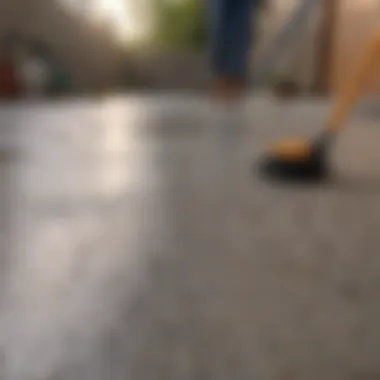
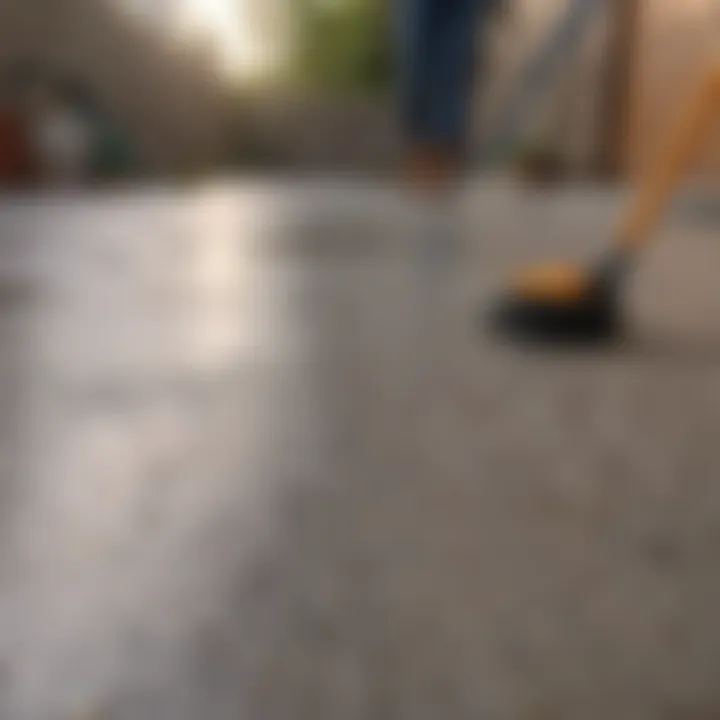
The basic soap and water method is among the simplest and most effective cleaning solutions for concrete patios. This mixture typically consists of water and a mild dish soap. One key characteristic is its accessibility; most households have soap on hand. This makes it a beneficial choice for people looking for an immediate solution.
The unique feature of this recipe lies in its gentle yet effective cleansing properties. Dish soap does not contain harsh chemicals, making it safe for both the environment and your concrete surface. However, while it is suitable for light to moderate cleaning, it may require more scrubbing effort on stubborn stains.
Application Process
The application process of the soap and water method is straightforward. First, sweep the patio to remove loose debris. Next, mix the soap with water in a bucket, ensuring it's well combined. Pour this solution onto the surface, ensuring even coverage. This method is beneficial because it allows for quick cleaning with minimal equipment.
An important aspect of this process is using a stiff-bristled brush to scrub the surface. This technique helps lift dirt and stains effectively. However, one disadvantage is that this method may not deeply penetrate heavy stains or mold, requiring alternative methods for significant issues.
Using Vinegar and Baking Soda
Combining Ingredients
Vinegar and baking soda is another effective method for cleaning concrete patios. This combination is particularly notable due to its eco-friendliness and non-toxic nature. The interaction between vinegar and baking soda creates a bubbling action that helps lift dirt and grime. This method is beneficial for those who prefer less chemical reliance.
The unique feature of this combination lies in its ability to tackle stubborn stains, such as oil and grime. However, caution is advised, as the acidic nature of vinegar can affect some sealants if the concrete is previously treated.
Scrubbing Techniques
When using the vinegar and baking soda method, scrubbing techniques are essential for achieving optimum results. After applying the mixture to the stains, let it sit for a short duration to allow chemical reactions to work. The key characteristic of this technique is its effectiveness in loosening grime without harsh scrubbing.
A disadvantage, however, can be a longer process as the bubbling action needs time to work. Users might find this method less effective against very old or deep-set stains.
Commercial Concrete Cleaners
Selecting Appropriate Products
For those who prefer a more robust cleaning approach, commercial concrete cleaners can be a great option. Selecting appropriate products requires understanding different formulations available. Often, these cleaners contain specific ingredients designed to tackle tough stains. A key characteristic is their effectiveness in quickly breaking down dirt and surface contaminants.
The unique feature of commercial cleaners lies in their targeted formulations, which can include special enzymes or chemical combinations for enhanced results. However, careful selection is crucial; not all products work the same way on every type of stain or surface condition.
Following Manufacturer Guidelines
Following manufacturer guidelines is vital when employing commercial cleaners. These guidelines usually provide details on the correct application process and safety precautions. Adhering to these instructions not only ensures effective cleaning but also promotes safety during use.
The main advantage of following the guidelines is that they often include tips for avoiding common mistakes, which can save time and prevent damage to the surface. However, these guidelines can vary widely between products, which may lead to confusion if multiple products are used inconsistently.
Removing Specific Stains
Removing specific stains from a concrete patio is a critical part of the cleaning process. Concrete is porous and can absorb various substances, leading to discoloration and a less appealing appearance. Stains from oil, grease, moss, or spills can accumulate over time, making the patio look neglected. Addressing these stains not only enhances the aesthetic value of the outdoor space but also preserves the integrity of the concrete. Understanding how to treat these stains can prevent damage and prolong the life of the surface.
Oil and Grease Remover Techniques
Oil and grease stains are common issues on concrete patios, especially in areas where grills or vehicles are parked. Removing these stains promptly is essential to prevent them from setting in permanently.
To effectively tackle oil and grease, begin by sprinkling an absorbent material such as cat litter or baking soda onto the stain. Allow it to sit for several hours or overnight to soak up the excess oil. Afterward, sweep away the absorbent material with a broom.
Next, prepare a cleaning solution. Combine warm water with a few drops of dish soap to create a mild degreaser. Use a stiff-bristled brush to scrub the affected area, applying pressure as needed. Rinse thoroughly with clean water to remove any soap residue. For stubborn stains, a commercial degreaser specific for concrete can be used, following the manufacturer's instructions.
Moss and Algae Treatment
Moss and algae can thrive on concrete patios, especially in shaded areas or regions with high humidity. Not only do they present a hazard as they can make surfaces slippery, but they also degrade the appearance of the patio. Regular treatment is vital to keep these organisms in check.
To remove moss and algae, start with a mixture of equal parts vinegar and water. Spray this solution directly onto the affected areas and let it sit for about 15 minutes. The acidity of the vinegar helps break down the moss and algae. Afterward, use a scrub brush to scrub the surface thoroughly. Rinse with a hose or bucket of water.
In cases of severe growth, a mixture of bleach and water may be necessary. However, take care to protect surrounding plants from bleach exposure. Ultimately, ensuring that your patio has adequate sunlight and good drainage can help prevent moss and algae growth in the future.
Cleaning Up After Spills
Spills on concrete can lead to unsightly stains if not addressed promptly. Whether it’s food, drink, or other substances, cleaning these up quickly minimizes the chance of long-term damage.
When a spill occurs, it’s crucial to act quickly. Start by blotting the area with paper towels or a cloth to absorb as much liquid as possible. Avoid wiping, as this can spread the stain further.
For solid spills, like food, scrape away the residue using a plastic spatula or spoon. Follow by cleaning the area with warm soapy water. For tougher stains, use a mixture of water and white vinegar or a suitable concrete cleaner. Gently scrub the area with a brush until the stain is removed. Rinse with clean water to ensure no residue is left behind.
Remember: Quick action is essential to prevent stains from becoming permanent. Regular maintenance and cleaning can keep your patio looking pristine.
Rinsing and Drying the Surface
The rinsing and drying phase is a critical part of maintaining a clean concrete patio. After applying any cleaning solution or method, it is essential to thoroughly rinse the area to ensure all residues and dirt are completely removed. If residues stay on the surface, they can lead to a dull appearance or even damages over time. Washing away these materials helps restore the patio to its optimal state, enhancing its usability and aesthetics.
Moreover, adequately drying the surface prevents water spots and mold growth. Leaving a wet patio unattended can create slippery conditions and might attract insects or algae. Thus, effectively rinsing and drying a concrete patio is necessary for both safety and longevity of the surface.
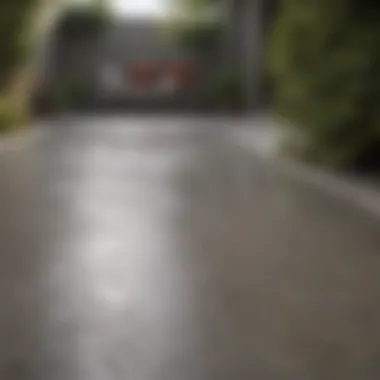
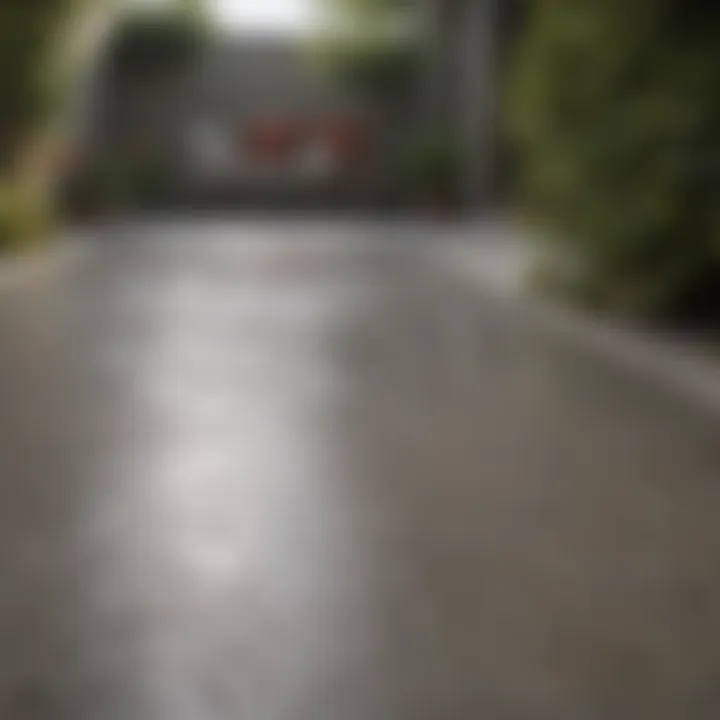
Effective Rinsing Methods
To achieve a good rinse after cleaning, various methods can be utilized based on the tools available and the extent of cleaning.
- Using a Garden Hose: A standard garden hose with a spray nozzle is one of the simplest ways to rinse your patio. Adjust the nozzle to a gentle spray setting to avoid displacing dirt or debris. It is recommended to start from one end, moving steadily to the other, ensuring an even rinse across the surface.
- Buckets of Water: If direct water pressure is limited, filling up buckets with water can also be effective. Pouring large amounts directly on the surface works to wash away any cleaning solution gently. A mop can assist in spreading the water evenly for a more thorough rinse.
- Wet-Dry Vacuum: For a more advanced technique, a wet-dry vacuum can be employed. This method sucks up both water and dirt. It is especially helpful in removing grime without needing to spread it elsewhere.
"Rinsing not only cleans but also prepares the patio for subsequent drying, which is equally important for maintenance."
Drying Techniques and Tips
After rinsing, ensuring that the patio dries properly will help maintain its condition. Different techniques can be adopted for effective drying:
- Sunlight Exposure: If the weather allows, direct sunlight can assist significantly in drying up the surface. Make sure there are no obstructions like furniture or landscaping that can block sunlight from reaching important areas.
- Mopping: A clean, dry mop can aid in wicking away excess water. This method helps to expedite the drying process, especially in shaded areas or during cooler weather.
- Towels or Rags: For faster drying in specific spots, using large towels or rags can be effective. This method is useful for high-traffic areas where water accumulation often occurs.
- Ventilation: If drying indoors is necessary, open windows or use fans to foster air movement, helping moisture evaporate more quickly.
In summary, rinsing and drying contribute significantly to the overall efficiency and efficacy of cleaning a concrete patio without a pressure washer. These steps ensure that efforts yield lasting results, making the space more enjoyable and safer for everyone.
Post-Cleaning Maintenance
Post-cleaning maintenance is crucial for preserving the pristine condition of your concrete patio. After putting in the effort to clean, it can be easy to overlook what comes next. This stage ensures not only that the surface remains appealing, but also that it is protected from future damage. By focusing on maintenance, homeowners can prolong the life of their patio and keep it looking its best throughout the seasons.
Sealing the Concrete Surface
Types of Sealants
Choosing the right type of sealant is essential for protecting your concrete patio. There are two main categories of sealants: penetrating sealants and topical sealants.
- Penetrating Sealants: These sealants infiltrate the concrete surface, providing protection against moisture and stains from within. This makes them a favorable choice for homeowners who want long-lasting defense that does not alter the appearance of the concrete. They often enhance the natural look without gloss.
- Topical Sealants: These create a protective layer on the surface of the concrete. They can add sheen and also provide a barrier against stains. However, they require more frequent reapplication due to wear and tear from outdoor elements. While they may offer immediate visual appeal, they might lack longevity compared to penetrating versions.
Overall, the choice between these types hinges on personal preference and the specific needs of the patio.
Application Process
The application process for sealants is integral to achieving a successful finish. Firstly, the surface must be thoroughly cleaned and allowed to dry completely. Applying a sealant on a damp surface leads to ineffective results.
- Application Techniques: Using a roller or sprayer can distribute sealant evenly. Ensure that you follow the manufacturer’s guidelines, including recommended drying times between coats. Applying multiple thin layers can produce the best results instead of one heavy layer.
- Unique Considerations: Consider weather conditions when planning application. Ideally, sealants should be applied during dry weather to prevent any interference from rain or dew. In addition, applying sealant too thickly can result in bubbling, thus reducing its effectiveness.
Thus, proper adherence to the application process can significantly impact the durability of the sealant.
Routine Cleaning Schedule
Establishing a routine cleaning schedule contributes to the long-term maintenance of your concrete patio. Consistent care allows for the prevention of significant stains and buildup that may prove challenging to remove. A suggested schedule could consist of light cleaning every couple of weeks and a more thorough cleaning every season.
Regular maintenance helps maintain the aesthetic of your outdoor space and simplifies cleaning chores in the long run.
In summary, focusing on sealing and establishing a routine cleaning regimen are key components of post-cleaning maintenance. Adopting these practices will ensure that your concrete patio remains an inviting space for years ahead.
Common Mistakes to Avoid
Cleaning a concrete patio can seem like a simple task, but it is easy to make mistakes that can affect the outcome. Understanding common pitfalls is important for a proper cleaning process. Avoiding these missteps can lead to better results and longer-lasting maintenance of the patio's appearance.
Using Harsh Chemicals
Using harsh chemicals is a common mistake many homeowners make when cleaning their concrete patios. While it may be tempting to reach for powerful cleaners that promise quick results, these substances can cause significant damage. They can lead to discoloration, erosion of the surface, or even create unsafe conditions by increasing slip hazards if residue remains.
When selecting a cleaning solution, aim for non-toxic and eco-friendly options. Natural ingredients like vinegar, baking soda, or mild dish soap can effectively remove dirt and stains without harming the concrete. Always test any cleaning solution in a small, inconspicuous area before applying it more broadly. This ensures the cleaner won’t have adverse effects on the patio material.
Neglecting Regular Maintenance
Neglecting regular maintenance is another critical mistake. A concrete patio requires a certain level of care to stay in good condition. Over time, dirt, stains, and other debris will accumulate, making deep cleaning necessary. However, if maintenance is overlooked, these issues become more challenging to handle, often requiring specialized treatments.
Setting up a routine cleaning schedule is advantageous. Here are a few simple tips for effective maintenance:
- Sweep regularly to remove debris that can cause stains or damage over time.
- Address spills quickly by cleaning them immediately to prevent stains from setting in.
- Inspect the surface often for cracks or chips. Early detection can prevent further damage and more extensive repair work later on.
Regular maintenance not only preserves the look of your concrete patio but also enhances its durability. Keeping up with these simple tasks ensures your outdoor space remains inviting and well-kept.
Epilogue
Cleaning a concrete patio without a pressure washer can seem daunting, yet the methods discussed in this article provide a practical roadmap. By following these techniques, homeowners can achieve a restored and inviting outdoor space. The key is to use appropriate tools, cleaning solutions, and techniques suited to the specific stains and conditions of the patio.
Summary of Effective Methods
To recap, the effective methods include using simple soap and water solutions, natural cleaners like vinegar and baking soda, and specific commercial products tailored for concrete cleaning. Each method holds distinct advantages depending on the type and severity of stains. A more eco-friendly approach could also be favored by many, reducing environmental impact while maintaining cleanliness.
Key Takeaways:
- Soap and Water: Ideal for general cleaning.
- Vinegar and Baking Soda: Effective for grime and lighter stains.
- Commercial Cleaners: Suitable for tough stains; always follow instructions carefully.
Encouragement for Ongoing Care
Regular maintenance is vital for keeping your patio clean and in good condition. Establishing a routine cleaning schedule not only enhances the appearance but also prolongs the life of the concrete. Homeowners should also consider resealing their patio regularly. This protects the surface from penetrating stains and damage caused by weather. Caring for your patio is an investment in your home’s exterior that pays dividends in the long run.















